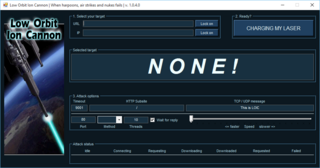
In computing, a denial-of-service attack is a cyber-attack in which the perpetrator seeks to make a machine or network resource unavailable to its intended users by temporarily or indefinitely disrupting services of a host connected to a network. Denial of service is typically accomplished by flooding the targeted machine or resource with superfluous requests in an attempt to overload systems and prevent some or all legitimate requests from being fulfilled. The range of attacks varies widely, spanning from inundating a server with millions of requests to slow its performance, overwhelming a server with a substantial amount of invalid data, to submitting requests with an illegitimate IP address.

In computing, a zombie is a computer connected to the Internet that has been compromised by a hacker via a computer virus, computer worm, or trojan horse program and can be used to perform malicious tasks under the remote direction of the hacker. Zombie computers often coordinate together in a botnet controlled by the hacker, and are used for activities such as spreading e-mail spam and launching distributed denial-of-service attacks against web servers. Most victims are unaware that their computers have become zombies. The concept is similar to the zombie of Haitian Voodoo folklore, which refers to a corpse resurrected by a sorcerer via magic and enslaved to the sorcerer's commands, having no free will of its own. A coordinated DDoS attack by multiple botnet machines also resembles a "zombie horde attack", as depicted in fictional zombie films.

A botnet is a group of Internet-connected devices, each of which runs one or more bots. Botnets can be used to perform Distributed Denial-of-Service (DDoS) attacks, steal data, send spam, and allow the attacker to access the device and its connection. The owner can control the botnet using command and control (C&C) software. The word "botnet" is a portmanteau of the words "robot" and "network". The term is usually used with a negative or malicious connotation.

Stacheldraht is malware which performs a distributed denial-of-service (DDoS) attack. It was written by "Thomas Stacheldraht", a member of the Austrian hacker group TESO. It was first released in 1999.
The trinoo or trin00 is a set of computer programs to conduct a DDoS attack. It is believed that trinoo networks have been set up on thousands of systems on the Internet that have been compromised by remote buffer overrun exploits.

Barrett Gibson Lyon is an American Internet entrepreneur, security researcher, and a former hacker.
Prolexic Technologies was a US-based provider of security solutions for protecting websites, data centers, and enterprise IP applications from Distributed Denial of Service (DDoS) attacks at the network, transport, and application layers. It operated a DDoS mitigation platform and a global network of traffic scrubbing centers. Real-time monitoring and mitigation services were provided by a 24/7 security operations control center (SOCC). Prolexic indicated its DDoS mitigation services make websites, data centers and enterprise IP applications harder to take down via DDoS attacks.

Anonymous is a decentralized international activist and hacktivist collective and movement primarily known for its various cyberattacks against several governments, government institutions and government agencies, corporations and the Church of Scientology.

Low Orbit Ion Cannon (LOIC) is an open-source network stress testing and denial-of-service attack application written in C#. LOIC was initially developed by Praetox Technologies, however it was later released into the public domain and is currently available on several open-source platforms.

Operation Payback was a coordinated, decentralized group of attacks on high-profile opponents of Internet piracy by Internet activists using the "Anonymous" moniker. Operation Payback started as retaliation to distributed denial of service (DDoS) attacks on torrent sites; piracy proponents then decided to launch DDoS attacks on piracy opponents. The initial reaction snowballed into a wave of attacks on major pro-copyright and anti-piracy organizations, law firms, and individuals. The Motion Picture Association of America, the Pirate Party UK and United States Pirate Party criticised the attacks.
Anonymous is a decentralized virtual community. They are commonly referred to as an internet-based collective of hacktivists whose goals, like its organization, are decentralized. Anonymous seeks mass awareness and revolution against what the organization perceives as corrupt entities, while attempting to maintain anonymity. Anonymous has had a hacktivist impact. This is a timeline of activities reported to be carried out by the group.

We Are Legion: The Story of the Hacktivists is a 2012 documentary film about the workings and beliefs of the self-described "hacktivist" collective, Anonymous.

Lizard Squad was a black hat hacking group, mainly known for their claims of distributed denial-of-service (DDoS) attacks primarily to disrupt gaming-related services.
Zemra is a DDoS Bot which was first discovered in underground forums in May 2012.
BASHLITE is malware which infects Linux systems in order to launch distributed denial-of-service attacks (DDoS). Originally it was also known under the name Bashdoor, but this term now refers to the exploit method used by the malware. It has been used to launch attacks of up to 400 Gbps.
R.U.D.Y., short for R U Dead Yet, is an acronym used to describe a Denial of Service (DoS) tool used by hackers to perform slow-rate a.k.a. “Low and slow” attacks by directing long form fields to the targeted server. It is known to have an interactive console, thus making it a user-friendly tool. It opens fewer connections to the website being targeted for a long period and keeps the sessions open as long as it is feasible. The amount of open sessions overtires the server or website making it unavailable for the authentic visitors. The data is sent in small packs at an incredibly slow rate; normally there is a gap of ten seconds between each byte but these intervals are not definite and may vary to avert detection.
Alexander Heid is an American computer security consultant, white hat hacker, and business executive.

On September 3, 2020, at 2:53 am EDT, a 16-year-old male from South Miami, Florida was arrested in connection with distributed denial-of-service (DDoS) attacks on the Miami-Dade County Public Schools's computer network, the fourth largest in the US, causing the system to crash during the first three days of the school year. It occurred as the school system was attempting to conduct internet-based instruction during the COVID-19 pandemic of 2020. After monitoring the IP addresses using the network, investigators concluded the teenager and several foreign actors had hacked the system. At the time, the school district had contracted Stride, Inc. to provide the software necessary for the internet-based instruction. Despite its price tag of $15.3 million, Stride was surprisingly susceptible to the attacks. Consequently, the school district sought the help of the FBI and U.S. Secret Service to investigate.
Anonymous, a decentralized international activist and hacktivist collective, has conducted numerous cyber-operations against Russia since February 2022 when the Russian invasion of Ukraine began.










